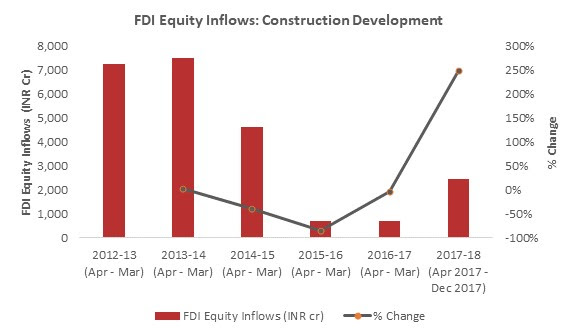Returning FDI Equity Scripting India’s Real Estate Revival?
Share Returning FDI Equity Scripting India’s Real Estate Revival?
As India rises to greater prominence on the world map, global corporates are more eager than ever to participate in the country’s growth story.
A GDP growth rate of 7% plus, a population base of over 1.2 billion and an urbanization rate northward of 30% are irresistible investment magnets, and real estate development remains a key focus area.
India opened its doors to FDI way back in the 2000s, and since then not only much-needed capital but also critical expertise has flowed in. No doubt, the subprime crisis of 2008 led to a decline in foreign fund inflows; however, today the situation has turned and certainly looks upbeat.
The real estate sector was among the main beneficiaries of the opening up of FDI into the country and has transformed significantly as a result. In the past few decades, it has metamorphosed from an unorganized, closely-held business to an increasingly organized and a corporatized one.
The recent structural changes including demonetization, the crackdown of Benami transactions, RERA and GST may have had short-term negative impacts, but they also encouraged the inflow of foreign funding which always reacts favourably to signs of increasing transparency, accountability and financial discipline.
Global investors certainly approve of the new regime, and their applause for the Government’s moves has taken the best possible form – namely a massive increase in the FDI equity inflows, especially into the development of self-sufficient townships, housing and supporting infrastructure.
A quick look at the statistics by the Departmental of Industrial Policy & Promotion (DIPP) indicates that just in nine months of FY 2017-18, FDI equity inflows into construction development rose by around 250% over the levels of FY 2016-17.
This sector has also been a key recipient of dollar-based FDI equity, accounting for around 7% of the total infusion between April 2000 to December 2017. Of course, the FDI equity that flowed into this sector between April-December 2017 does not beat the high levels witnessed in 2012-13 and 2013-14.
However, the decisive return of foreign funding has certainly turned the tide for the construction development sector, which was swimming against the negative currents of subdued demand and disruptive policy changes over the past few years.
Other positives to this revival:
- The rise in FDI equity inflows indicates that global players are once again willing to back the sector. This is solely because the business environment has changed positively because of the RERA regime and other regulatory changes.
- In the past few years, debt transactions more or less ruled the market, as investors were not sure of whether equity investments would fetch the desired returns. In fact, not a few investors got burned in the previously unregulated market environment. The return of FDI equity is not only a big positive to the sector which will help to improve developers’ leverage ratios – it is also a resounding vote of confidence in the sector.
- The rise in FDI is a lead indicator of a positive future for the Indian real estate sector – which, as everyone knows, is a critical component of the country’s economy. The Indian real estate sector is the country’s second-largest employer, has thousands of allied industries and presently contributes 8-9% to the country’s GDP.
We have more than enough reason to feel upbeat about the improvement in FDI equity inflows into the construction development sector. Nevertheless, we cannot forget that this is a revival, not a tidal wave of growth. In other words, the Government has to ensure that the exuberance does not fade away.
It can do so by:
- Enforcing a tighter control regime and constantly monitoring all mechanisms to ensure that there are no stutters in the system set by the current regulator.
- Taking decisive punitive actions against defaulters to send a strong message to global investors that the watchdog is alive and kicking.
- Providing more benefits and incentives, and easier processes to seek larger foreign investments. While the improvement in the ease of doing business ranking from 130 to 100 is a big positive, the Government has to.
- Maintain a consistent upward learning curve and communicate new evolutionary developments to the world.
- Widening the investment avenues by bringing the benefits of the organization to more real estate sub-asset classes such as rental housing development, student housing and senior citizen living.
Only time will tell if the revival of FDI equity inflows into the construction development sector is sustainable and will culminate in a full-fledged comeback.
The macroeconomic fundamentals are surely encouraging, and if the latest policy initiatives stand strong and result in even more regulatory refinements in the future, we will certainly see the next wave of development announce the arrival of India 2.0 to the world.
Request a Call Back

